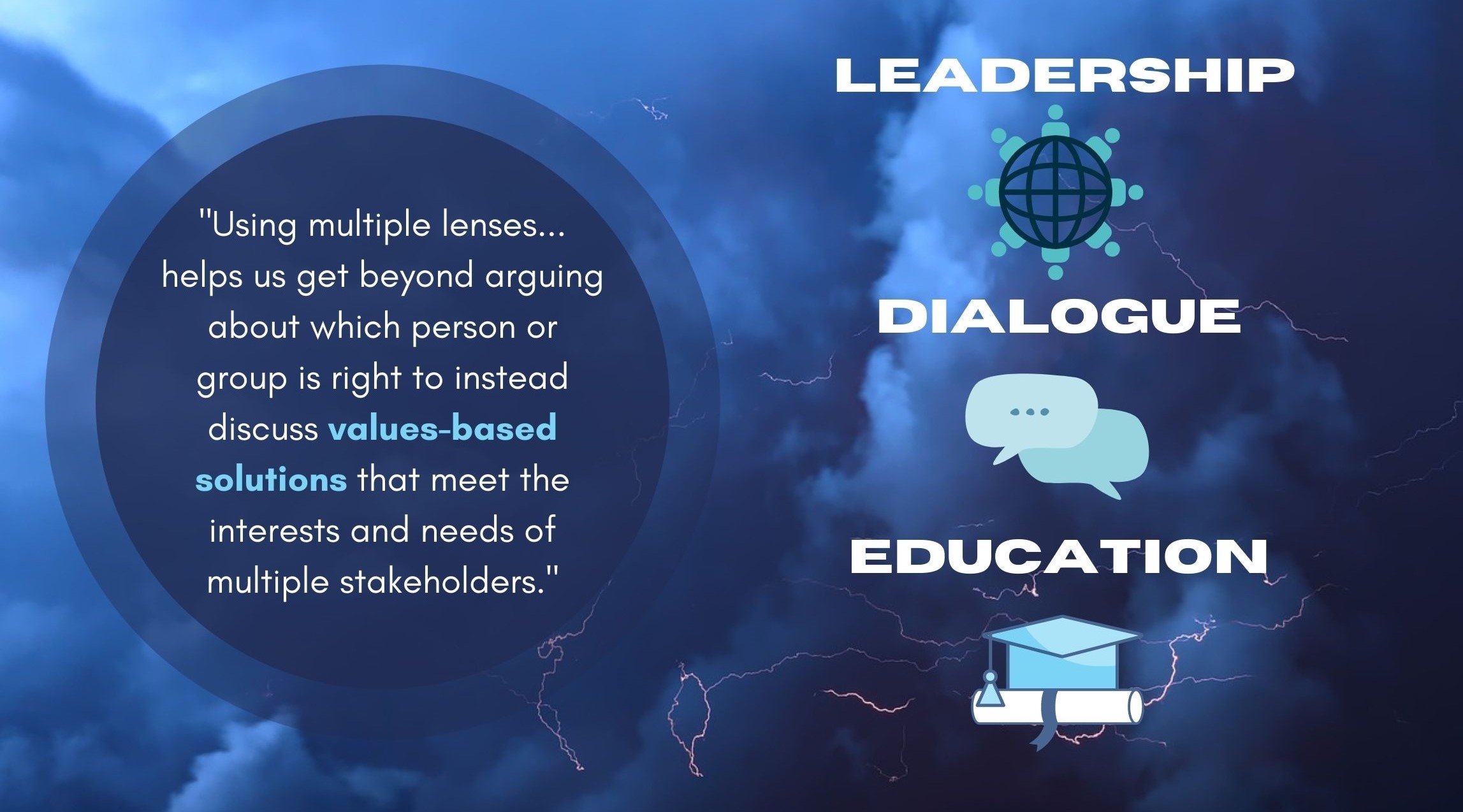
A Broader Context For Acting On Values
By Linda Fisher Thornton
To build good organizations and healthy communities, we will need good leaders at every level who are committed to leading with values. These values-driven leaders will need to assess their impact on multiple stakeholders as they navigate through complexity to make good decisions and lead in ethical ways.
The 7 Lenses of Ethical Leadership
We are experiencing values conflicts around the world as people advocate for what they feel is right. The many interpretations of what is right vary to such a degree that people begin to see themselves as living in different worlds, making it more difficult to reach a shared understanding of the way forward. There is, however, a way to see these varying interpretations of what is right in a broader context that will make it easier to talk about them and make values-based decisions together.
It is difficult to define values-based leadership because as the world changes, our understanding of what it means to lead responsibly in that world also changes. To overcome that challenge, values-based leadership is best viewed from a developmental perspective, with leaders using a broader schema for their learning and development to keep up with increasing expectations.
The model outlined in my book 7 Lenses frames values-based leadership as a developmental continuum based on these assumptions:
- People grow.
- People’s understanding of leadership responsibility grows as they learn and develop as human beings.
- Times change.
- The standards for acceptable behavior and leadership evolve as times change.
- The world is complex and connected.
- The complexity and connections call for a higher level of complexity in our thinking.
- Thinking at a higher level of complexity means that we can consider more constituents and more variables when making decisions.
Here are 7 different interpretations of what is ethically good, based on the model in my book 7 Lenses: Learning the Principles and Practices of Ethical Leadership. These 7 interpretations of good leadership serve as a schema for seeing values in a broader context. Which ones are you using in your day-to-day leadership?
1 – Profit
Using the Profit Lens, we see what is good in a money sense. Through the Profit perspective, the goal of leadership is to ensure that the organization makes a profit so that it can continue its work. Good means what is good for economic growth, income growth, and organizational growth.
2 – Law
Using the Law Lens, we see what is good in a legal sense. Good means following all laws and regulations and ethics codes.
3 – Character
Using the Character Lens, we see what is good in a morally grounded sense. Good means demonstrating character and integrity and showing a high degree of moral awareness.
4 – People
Using the People Lens, we see what is good for people’s well-being. Through the People perspective, the goal of leadership is to bring out the best in people through respect, care, and continual support for their success.
5 – Communities
Using the Communities Lens, we see what is good for the health and well-being of communities. Through the Communities Lens, the goal of leadership is to serve others in ways that uplift lives, support thriving families, and provide needed community services.
6 – Planet
Using the Planet Lens, we see what is good for the planet and nature. Good means protecting plants, wildlife, and natural lands, and treating the planet and ecosystems that we depend on with care.
7 – Greater Good
Using the Greater Good Lens, we see what is good in the broadest sense, at the highest level, for the longest-term. Good is what creates a peaceful, global society where all people can thrive. Using the Greater Good perspective, the goal of leadership is to make choices that ensure a good life for future generations.
A Multi-Stakeholder View of Values
The question is not “Which one of these seven perspectives or lenses is right?” because they are all ways we need to be thinking about our values. They are all part of a bigger view that incorporates many dimensions of responsibility. Instead, the question is “How can we honor all of them?” Regardless of level or title, the most competent ethical leaders make it a priority to learn, and they work to stay competent in all 7 dimensions of ethical responsibility as the world changes.
The 7 Lenses reflect global priorities for building our shared future, as documented in the United Nations Sustainable Development Goals, The Caux Round Table Principles, and other globally developed goals and principles. Understanding values in this broader context gives us a clear picture of the multi-stakeholder approach to decisions and actions. It gives us the bigger picture of the kind of values-based leadership thinking that is essential to our collective success.
Reconnecting With Values
How will this 7 Lenses model improve our dialogue about the nuances of ethical leadership? It will:
- Give us a common non-confrontational language for talking about values
- Move us beyond arguing and taking sides to a collective benefit perspective
- Help us describe examples of values in action and call out what’s missing in ethical failures
- Shift our focus from posturing, politics, or party to impactful values-based leadership
- Help us connect with the values that will drive our successful shared future
Our theme for this World Values Day is Reconnecting. Seeing through all 7 Lenses connects the disparate pieces of ethical responsibility and leadership that have been discussed separately in the past. Using multiple lenses helps us avoid myopia, group think, and a sole focus on self-interest. It helps us get beyond arguing about which person or group is right to instead discuss values-based solutions that meet the interests and needs of multiple stakeholders.
This broader context for understanding the values of good leadership helps us see the value of building better organizations and communities. The kaleidoscopic view we see through all 7 Lenses balances self-interest, law, other-interest, and planetary and societal interests, putting them into a broader perspective. This kind of multivariable thinking and dialogue is what we need to educate the leaders of the future and handle our current challenges in the global sphere together.
Contains Content From These Previously Published Posts:
https://leadingincontext.com/2014/02/12/what-is-the-purpose-of-leadership/
https://leadingincontext.com/2014/09/17/7-definitions-of-good-why-we-disagree-about-ethics/
https://leadingincontext.com/2017/04/19/is-your-leadership-good/
© 2021 Leading in Context LLC
About the Author:

Linda Fisher Thornton, a former bank Chief Learning Officer and author of 7 Lenses, is on a mission to Unleash the Positive Power of Ethical Leadership. She trains leadership groups across industries and borders on ethical awareness, decision making, and ethical leadership as CEO of Leading in Context LLC and teaches as Adjunct Associate Professor of Ethics and Leadership for the University of Richmond. She blogs at LeadinginContext.com.
Resources:
7 Lenses on Amazon
What Ethical Leaders Believe (A Manifesto)
Ethical Thinking Isn’t Automatic





